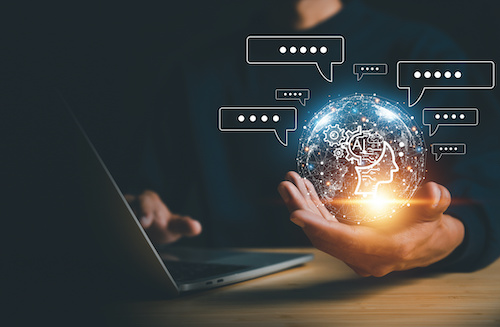Key points:
AI offers a customized approach to learning, depending on individual needs
Google, MIT RAISE launch no-cost AI training course for teachers
How digital tools and AI can enhance social studies
For more news on AI in education, visit eSN’s Digital Learning hub
Emerging artificial intelligence (AI) is becoming a powerful driving force behind educational technology, fundamentally shifting educational dynamics and how students learn and receive support.
AI tutoring systems spearhead this learning revolution by reimagining the tutoring concept, offering interactive and adaptive learning experiences customized to each individual’s learning capabilities. AI tutoring can change students’ learning experiences by providing access to an environment designed according to their learning styles and paces.
The power of personalized learning
AI can transform various aspects of society, such as medicine, transportation, and education. A significant advantage of AI tutoring systems is the personalized learning experiences they can offer students. Unlike traditional tutoring formats, in which the materials and pace of delivery are standardized for students, AI systems track students’ performance, monitoring shifts in student strengths and weaknesses and adapting the type of content, its delivery method, and speed accordingly.
Intelligent AI tutoring programs accomplish this feat by using machine learning algorithms to detect patterns in how students interact with the software during study sessions. The system analyzes these patterns and adjusts its tutoring approach to match individual learning styles.
While AI tutoring offers a new way for students to approach learning, educators, parents, and students must use it cautiously. Parents, teachers, and students should know the potential dangers of using AI online. Currently, there is little governance or regulation of AI platforms and programs. AI systems sometimes lead to data privacy violations, cybersecurity threats, and AI-generated misinformation.
Algorithmic biases are also a concern, as data collected by AI programs may cause discrimination based on factors such as income levels and race. Parents and educators should carefully review any AI tutoring program’s strengths and weaknesses before students begin to work with it.
Targeted assistance and adaptive feedback
AI tutoring systems do an excellent job of delivering customizable support and feedback that align with student patterns in need. Because AI machine learning breaks down student learning patterns and habits, the tutoring systems fire off explanations, examples, and practice targeting a student’s most significant areas of need when the software recognizes the student’s knowledge gap or struggles with mastery.
This level of responsiveness is invaluable when teaching any subject where a single knowledge void or misunderstanding can completely derail a student’s progress, from mathematics to programming. AI tutoring systems give students immediate feedback on areas of concern so they and their instructors can address problematic knowledge issues before they become severe.
When students learn a topic quickly, an AI tutoring system can speed up and offer them more challenging material that remains appropriately difficult for them. On the other hand, if students can’t grasp a concept after trying several examples, practicing the problems, and receiving multiple explanations, the system will slow the pace of the lesson. It can provide more examples and problems until the student succeeds.
This type of responsiveness is extremely valuable in subjects such as mathematics or programming, where one knowledge gap or misunderstanding can prevent further progress. AI tutoring systems give students immediate feedback and guidance, addressing these problem areas before they become more severe.
Additionally, AI tutoring systems can adjust the pace and level of instruction in response to students’ assessments and progress. If students master the material quickly, the system can accelerate their work pace to move them onto more advanced topics, keeping them challenged and engaged. On the other hand, when students struggle with academic material, these tutoring programs can provide relevant and explanatory examples, practice exercises, and alternative explanations until the student achieves a reasonable mastery of those concepts.
Enhancing student engagement and motivation
Beyond academic support, AI tutoring systems can also improve student engagement and motivation. By implementing gamification techniques, such as progress tracking, reward systems, and interactive challenges, these systems can enhance student participation and deliver more fun while learning. Students can be motivated by their progress, giving them a sense of accomplishment and encouraging them to persevere through challenging material.
AI tutoring systems include personalized encouragement and positive reinforcement by recognizing and celebrating student achievements. This level of individualized attention and support can boost students’ self-confidence, leading them to become more responsible for their learning and inspiring them to strive for continuous improvement.
The future of AI-powered education
Though AI tutoring systems are still in their infancy, many educators predict they will quickly reshape how students learn. Imagine AI tutoring combined with augmented or virtual reality technology to create interactive learning environments designed around students’ interests and learning styles. These tutoring programs may also align with natural language processing and conversational AI to talk and interact with students in more natural dialogue, providing more accurate real-time feedback.
Parents should familiarize themselves with AI tutoring platforms’ ability to help their children academically succeed while also becoming aware of the dangers AI can pose. These tutoring programs can assist children with other aspects of their learning–for example, AI tutoring offers homework assistance to students struggling with specific tasks and engages students in self-directed activities like learning new concepts or languages. It is also a helpful outlet for students to find research for school papers or projects by gathering sources from the internet and collating them into a single document.
However, AI poses potential dangers to students, including data, privacy concerns, and inherent bias that can spread misinformation. Parents should speak to their children about the benefits and drawbacks of using AI technology and establish clear boundaries as to when they should or should not use these platforms.
AI tutoring and the future of education
The more advanced AI becomes, the more it has the potential to enrich education. The possibilities are endless; however, for these opportunities to be realized, educators need to use AI wisely and not let AI dictate the future of education. Students should be able to use AI tutoring programs to help them develop an enduring energy and motivation to learn, including from their errors.
Emerging artificial intelligence (AI) is becoming a powerful driving force behind educational technology, fundamentally shifting educational dynamics and how students learn and receive support. AI in Education, Digital Learning, Featured on eSchool News, adaptive learning, Education, educational technology, interactive, learning, learning styles, personalized learning, students, styles, support eSchool News








